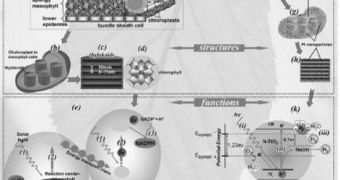Many scientists around the world have over the past few years attempted to create an artificial leaf based directly on Mother Nature's design. The reason why such a device needs to be obtained is that it would basically convert sunlight into energy using the same process that all vegetation does, and namely photosynthesis. This could allow for the development of a new source of alternative energy that could become much more efficient at harnessing the energy of the Sun that existing photovoltaic cells. Now, a group of scientists present their newest research in artificial leaves.
Speaking yesterday, March 25, in San Francisco, Chinese researchers from the Shanghai Jiaotong University State Key Lab of Matrix Composites told the 239th National Meeting of the American Chemical Society (ACS) that a new design strategy for the production of artificial, working leaf prototypes has been devised. The approach, they added, is based entirely on the biological and chemical processes going on in the actual leaves. If properly applied into artificial systems, then these reactions could be used to convert water and sunlight into energy, and maybe even hydrogen fuel, for use inside new generations of fuel cells.
“This concept may provide a new vista for the design of artificial photosynthetic systems based on biological paradigms and build a working prototype to exploit sustainable energy resources,” explained SJU expert Tongxiang Fan, PhD, who conducted the new research alongside colleagues Di Zhang, PhD and Han Zhou, PhD. All three scientists are based at the State Key Lab of Matrix Composites. The group is part of a much wider group of researchers around the world, that believes splitting water into its basic components, namely hydrogen and oxygen, could lead to the emergence of a new sustainable way of producing energy.
“Our results may represent an important first step towards the design of novel artificial solar energy transduction systems based on natural paradigms, particularly based on exploring and mimicking the structural design. Nature still has much to teach us, and human ingenuity can modify the principles of natural systems for enhanced utility,” Fan said at the meeting.

 14 DAY TRIAL //
14 DAY TRIAL //